Kakinomoto no Hitomaro
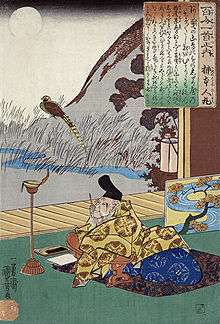
Kakinomoto no Hitomaro (柿本人麻呂 or 柿本人麿) was a Japanese waka poet and aristocrat of the late Asuka period. He was the most prominent of the poets included in the Man'yōshū, and was particularly represented in volumes 1 and 2. He is ranked as one of the Thirty-six Poetry Immortals. From the Heian period on, he was often called "Hito-maru" (人丸).
Works and style
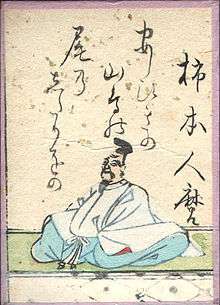
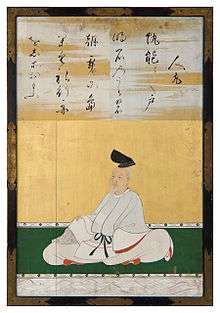
Hitomaro is famed for his long poems, such as "In the sea of ivy clothed Iwami",[1] "The Bay of Tsunu",[2] and "I loved her like the leaves." 19 of his chōka ("long poems") were included in the Man'yōshū and 75 or so tanka ("short poems") were likewise selected. Many of his poems were written on the topics of public occasions; such as his "Lament for Prince Takechi", written as part of the mourning ceremonies for Takechi. Other poems were written on occasions in his life when he was particularly moved: parting from his wife, mourning for his wife, or on seeing a corpse.
His style makes use of figures of speech such as makurakotoba, jokotoba, and ouin (押韻) or rhyme. Among his chōka, he makes use of complex and variant taiku (対句) or antithesis. In his tanka, Hitomaro makes use of nearly 140 makurakotoba, among which half are not seen in previous works, which attests to his originality.In addition, his poetry includes kotodama such as:
- Shikishima no / Yamato no kuni ha / kototama no / tasukuru kuni zo / masakiku ari koso
- (敷島の 大和の国は 言霊の 助くる国ぞ まさきくありこそ)
- (Man'yōshū Vol. 13, 3254)
In his hymns and elegies, he uses expressions such "Should his highness be a god" (大君は 神にしませば), "Being a god, becoming to a god" (神ながら 神さびせすと), and "Prince of the sun, shining on high" (高照らす 日の皇子) to highly glorify the emperor as an ascendant divinity and express his deeds. While examples of such expressions of the emperor as an ascendant divinity do appear in ancient historical works and folk songs, they are featured so prominently in Hitomaro's works as to make him stand out among all other contemporary poets. Further, such expressions quickly declined in use after Hitomaro, as the national enforcement of ritsuryō regulations between Emperor Temmu's reign and Jitō's court had encouraged him. In effect, such expressions can be seen as a product of the regulations of the time.
In regards to his love poetry, there are a number of extant chōka to women, and it was used to be thought by some, such as Mokichi Saitō, that he held numerous wives and mistresses. It is a more widely accepted interpretation today that Hitomaro is composing love stories rather than putting to verse his own experiences. Regardless if the contents are fact or fiction, Hitomaro placed emphasis on married life together, and the love poems capture his expressive nature.[3]
The following waka makes use of both makurakotoba and jokotoba and is attributed to Hitomaro by Fujiwara no Teika. The source of this poem, however, is from a variant tradition of Man'yōshū Vol. 12, 2802, and was included as the third poem in the Ogura Hyakunin Isshu:
- (Man'yōgana) 足日木乃 山鳥之尾乃 四垂尾之 長永夜乎 一鴨將宿
- (Hiragana) あしびきの 山鳥の尾の しだり尾の ながながし夜を ひとりかも寝む
- Ashibiki no / yamadori no o no / shidari o no / naganagashi yo wo / hitori kamo nen
Some scholars debate that this poem was actually composed by Hitomaro, as it was preserved in the Shūi Wakashū.
Rough translation: When it becomes night, like the mountain birds that part and sleep in sad loneliness, what a long, long night I may sleep in sad loneliness.
Life
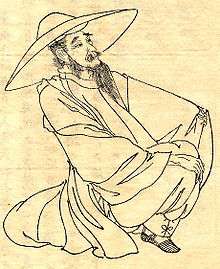
Details of his life are few and uncertain despite his prominence as a poet. His name doesn't appear in chronicles like the Nihon Shoki nor in Shoku Nihongi ("History of Japan" II). All our primary sources about him come from the prefaces and commentaries on the Man'yōshū where he is designated as either the composer or collector of waka poetry.
Generally, he is thought to have begun working in the court under Emperor Temmu's 9th year (680 CE),[4] and was active as a poet Temmu's reign and likely flourished under Empress Jitō. However, since Kakinomoto composed a pair of poems mourning the death of a lady in the court of Emperor Tenji at Oumi,[5] there are some scholars like Kitayama Shigeo (北山茂夫) who believe he began work at the court in Oumi.
According to the Edo period scholar Kamo no Mabuchi, he served under Prince Kusakabe, and while this is often held as true, there is actually very little concrete evidence for this claim. On the other hand, since he presented poems to numerous princes and princesses (such as Yuge no Miko (弓削皇子), Prince Toneri, and Niitabeshin no U (新田部親王)), it is thought to be unlikely that he was in the service of a single prince. Others, such as the Japanese scholars Itō Haku and Hashimoto Tatsuo, believe that he was an imperial poet of the court, but no such position as "imperial poet" existed during the Asuka period. The group of Hitomaro's poems which can be dated within a certain period does overlap approximately with Empress Jitō's ascension and death, and so it is thought that the empress was a motivational force for Hitomaro's poetry.
From waka mourning the death of a man from Sanuki Province,[6] and a farewell poem at Kamoyama (Mt. Kamo) in Iwami province with elegies (banka, 挽歌) mourning his own death,[7] many have seen this as Hitomaro acting as a palace official traveling to various provinces and reaching the end of his life in Iwami. According to the Japanese scholar Itō Haku, however, this farewell poem is a folk drama portraying Hitomaro's own death, and the theory that the poem is a later counterfeit has also been suggested.
Further, from waka mourning the death of Princess Asuka, who died in the 4th year of Emperor Mommu's reign (700 CE), it is certain that Hitomaro was still present at the capitol after Prince Kusakabe's death (689 CE). Because there are no works certain extant from the later half of the Fujiwara-kyō period or after the capitol moved to Nara, it is thought that Hitomaro died before 710 CE.
When he was around 50 years old, there are records indicating that he was appointed to a provincial office in Iwami Province — today the western part of Shimane Prefecture. In 708, Zokunihongi reports that a "Kakinomoto no Saru" (another member of the Kakinomoto clan) died; the Japanese thinker Umehara Takeshi has suggested that this Saru (柿本佐留) and Hitomaro were the same person.
Family background
The Kakinomoto clan into which Hitomaro was born was an aristocratic court clan of middling prestige and rank. In the clan, he was referred to as Ason, signifying that he held the third highest title of eight. In earlier years, the clan served the court mainly by holding religious ceremonies with singing and reciting of poems. It had a deep relation to the Sarume clan whose legendary founder was Ame-no-Uzume, the dancer goddess. It can be supposed Hitomaro grew up in an artistic atmosphere.
The Kakinomoto name can be traced to the 4th-century C.E. aristocratic Kasuga family, descended from Emperor Kōshō. According to the Sekishū Masuda family-tree diagram (石州益田家系図) from the Shoshikechō (諸氏家牒), his father was Kakinomoto no Ooba (柿本大庭) and his brother's name was Kakinomoto no Saru (柿本 猨/佐留). In a different document, Hitomaro (人万呂/人麿) is recorded as the Saru's son, but this remains doubtful. In the same document, Hitomaro's son is given as Ninomaro (蓑麿), whose mother is Yosami Koromoya-musumego (依羅衣屋娘子). His descendants established themselves in the Iwami province as local administrators of Mino, and from the Kamakura period became part of the regional warrior caste under the name of the Masuda clan. As there are no historical sources contemporary to Hitomaro's time, these historicity of these documents are difficult to verify.
Fame
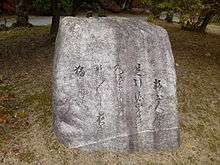
In the prefatory essay to the Kokin Wakashū compilation of poetry, Ki no Tsurayuki called him Uta no Hijiri — a divine poet equal to the Nara period poet Yamabe no Akahito, a high regard echoed by later poets such as Fujiwara no Teika. Ikeda Munemasa wrote Portrait of Hitomaro and His Waka Poem. Modern waka poets like Masaoka Shiki and Saito Mokichi considered him one of greatest poets in the history of Japanese literature.
In Masuda, Iwami Province in Shimane Prefecture, there are two Kakinomoto shrines, Takatsu Kakinomoto Shrine and Toda Kakinomoto Shrine. It is said that Kamoshima in Masuda is Hitomaro's death place and Toda is Hitomaro's birthplace. The priest of Toda Kakinomoto Shrine is Ayabe, and he is the 49th of Hitomaro's mother's line.
In Akashi, Hyōgo Prefecture there is Kakinomoto Jinja, a shrine devoted to Hitomaro. The shrine holds an annual utakai (waka party) devoted to him.
References
- ↑ "2001 Waka - Waka No.30". shef.ac.uk.
- ↑ "2001 Waka - Waka No.26". shef.ac.uk.
- ↑ Kubota Utsubo's A Commentary on the Man'yōshū (万葉集評釈)
- ↑ (Commentary on Man'yōshū Vol.10, 2033)
- ↑ (Man'yōshū Vol. 2, 217 and 219)
- ↑ (Man'yōshū Vol. 2, 220-222)
- ↑ (Man'yōshū Vol. 2, 223-227)
External links
![]() Media related to Kakinomoto no Hitomaro at Wikimedia Commons
Media related to Kakinomoto no Hitomaro at Wikimedia Commons
- The 2001 Waka for Japan 2001 collection contains a large selection of translations of Hitomaro's poetry, mostly from the Man'yōshū
- Kenneth Rexroth's One Hundred Poems from the Japanese (New Directions, 1955, ISBN 0-8112-0181-3) contains several of Hitomaro's waka, as well as notable translations of 3 naga uta ("In the sea of ivy clothed Iwami", "The Bay of Tsyunu", and "When she was still alive")
- Takatsu Kakinomoto Shrine.